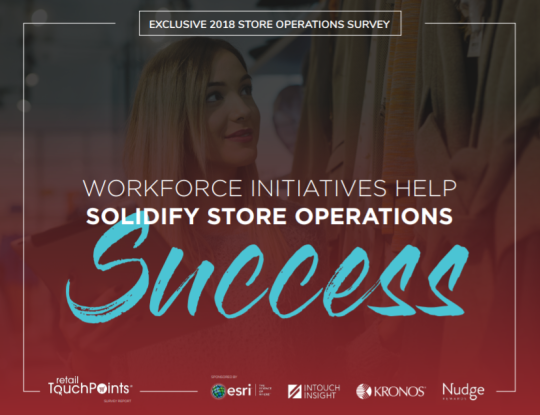
This sixth annual Retail
TouchPoints Store Operations Survey examines the top challenges omnichannel
retailers face in shoring up their brick-and-mortar locations, and reveals the
strategies and technology solutions they are using to meet those challenges.
On top of the basics that have always been part of store
operations, today’s stores now must offer online-level
convenience, seamless channel integration and unique customer experiences.
In this week’s Editor Q&A, the RTP team shares top takeaways, impressions and reactions from the 2018
Store Operations Survey.
Debbie Hauss,
Editor-in-Chief: One of the most important focuses for retailers determined
to survive into the future with their stores is workforce management and motivation. Bottom line: Employees and
store managers are the front line brand
advocates. If they are not motivated, educated and empowered, the brand
will suffer. So it’s good to see that retailers are acknowledging the
challenges (50% cite employee training/engagement as the
greatest store operations challenge); and it’s great to see that many are
embracing a strong go-forward strategy (41%
have increased investments in employee training/engagement this year). One
important focus involves better scheduling practices; and it’s encouraging to
see that many retailers are implementing predictive scheduling solutions
designed to give employees more options and control over their schedules (52% have implemented, or are planning
to implement, predictive scheduling).
Adam Blair, Executive
Editor: For an industry that, by its nature, must focus on
the present moment, a lot of retailers still seem willing to live in the past.
Reviewing the 2018 Store Operations Survey, it struck me as odd that even
though we’ve repeated the mantra about the importance of omnichannel until
we’re all blue in the face, store performance metrics still hearken back to the
earliest days of e-Commerce. Nearly two thirds (65%) of retailers still
use same-store sales as a KPI, but only 7% factor in
online-to-store conversion rates. That’s despite study after study showing that
the vast majority of shopper journeys begin in the digital realm, and that
shoppers use their mobile devices extensively while they are in
brick-and-mortar stores. I know it’s tough to realign measurement systems that
have been in place for years, but retailers need to figure out how to do it —
and quickly. Remember the old saying: You can’t manage what
you don’t measure.
Alicia Esposito,
Content Strategist: Flexible fulfillment — especially buy online, pick up
in-store (BOPIS) — is undeniably table stakes for all retailers. Most survey respondents
have adopted buy online, ship to home (70%),
buy online, pick up in-store (64%)
and buy online, return to store (63%).
Despite the integral role of the store in supporting these last mile offerings,
however, the majority of respondents (69%)
said 10% or less of associate labor hours are spent handling online order
fulfillment. Does this mean that not as many consumers are embracing these last
mile offerings? Or does it mean that retailers are not effectively promoting
and optimizing these experiences so that they can maximize the revenue
potential? Retailers have an opportunity to extend high-touch service to the
fulfillment process, empowering associates with digital technology so they can
consult with consumers as they finalize their transactions. Do I think not
focusing on the last mile is a lost opportunity? Yes, but there’s always next
year!
Glenn Taylor, Senior
Editor: I’m just glad, among all the highlights in the report, that 41% of retailers said their store
budgets increased in 2018, with 40% keeping
on par with last year. The combined 81%
total well surpasses the 67% in both
2016 and 2017, another indication that retailers are making more investments
where they need to. While everyone would love to see increases across employee
hiring and training, the investments in mobile technology and connectivity are
nearly as important for the future success of these retailers as the people
are. Building a store that can be relevant to a shopper sitting at home on her couch
will remain a big battleground over the next few years, so the ones that are
shoring up this technology now are making the right decision.
Bryan Wassel,
Associate Editor: The biggest takeaway for me is that mobile technology
isn’t just changing how shoppers interact with retailers — it’s changing how
associates interact with shoppers. Modern customers enter stores armed with
computers in their pockets, making them more educated and knowledgeable than
ever, while 56% of retailers are arming their employees with
their own mobile technology. Some of the most popular in-store uses of mobile
represent more in-depth shopper-associate relationships, such as the 42% of
retailers using the technology for clienteling/assisted selling.
More informed shoppers must be attended by more informed associates, a feedback
loop that is being enabled by the growing importance of mobile. Retailers that recognize
the importance of this new dimension of brick-and-mortar are already seeing
results: mobile increased customer satisfaction for 64% of
retailers this year.






